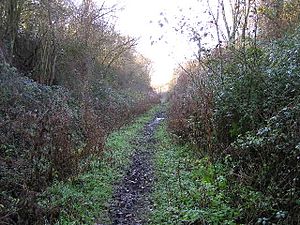- This page was last modified on 17 October 2025, at 10:18. Suggest an edit.
Lineage Wood & Railway Track, Long Melford facts for kids
| Site of Special Scientific Interest | |
 |
|
| Area of Search | Suffolk |
|---|---|
| Interest | Biological |
| Area | 78.7 hectares |
| Notification | 1987 |
| Location map | Magic Map |
Lineage Wood & Railway Track, Long Melford is a special place in Suffolk, England. It covers about 78.7 hectares, which is like 194 football fields! This area is known as a Site of Special Scientific Interest (SSSI) because it's home to many important plants and animals. It's a protected area where nature can thrive.
Contents
What Makes This Place Special?
Lineage Wood and the old railway track are important for different reasons. The wood has grassy paths with many types of plants. The old railway line also has lots of beautiful flowers and grasses.
Amazing Plants and Animals
This area is a fantastic spot for nature lovers. You can find a wide variety of plants, especially different kinds of orchids. It's also a haven for butterflies!
Wonderful Orchids
In Lineage Wood, you can see several types of orchids. These include the tall greater butterfly orchid and the unique fly orchid. You might also spot the pretty common spotted orchid and the clever bee orchid. These beautiful flowers grow well in the wood's grassy areas.
Butterflies Galore
If you love butterflies, this place is for you! Experts have counted 22 different kinds of butterflies here. They flutter among the flowers, adding bright colors to the landscape. The diverse plants provide food and homes for these insects.
Exploring the Area
Lineage Wood itself is private land, so you cannot walk through it. However, you can still enjoy some of the natural beauty!
The St Edmund Way Footpath
A public path called the St Edmund Way runs along the old railway line. This means you can walk or cycle along this part of the SSSI. It's a great way to see some of the special plants and perhaps spot some butterflies. The soil along the railway line is a bit different, which means different kinds of plants grow there.
